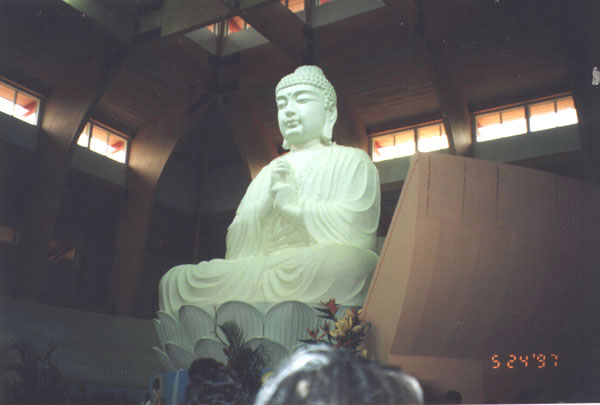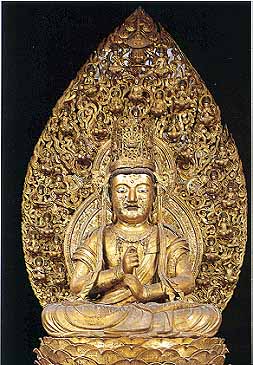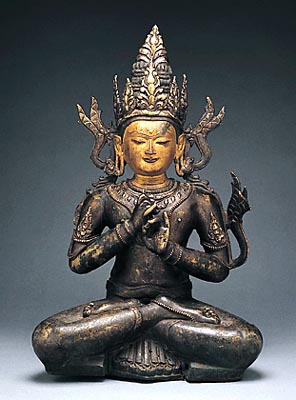| About Us | Site Map | Contact Us |
|
|
| Home | Schools & Teachings | Dharma Centers | Buddha & Bodhisattva Directory | Cosmos |
|
|
Buddha and Bodhisattva Directory
Vairocana
|
The name means "he who is like the sun" or "the radiating one."
Vairocana is also called Mahavairocana ("Great Illuminator"), the supreme Buddha, as regarded by many Mahayana Buddhists of East Asia and of Tibet, Nepal, and Java. In the Mi-tsung sect of China and Shingon sect of Japan, he is the chief object of reverence and is regarded as the source of the entire universe. The characteristic gesture displays in these two regions is the mudra of the six elements, in which the index finger of the left hand is clasped by the five fingers of the right, symbolizing the uniting of the five elements of the material world (earth, water, fire, air, and ether) with the spiritual (consciousness). The other gesture popular in Vairocana statues is in the dharma-chakra-mudra ("teaching gesture").
In China and Japan, Vairocana is given reverence by the school of Secrets (the Mi-tsung and Shingon sects). Legend claims that he transmitted to a supernatural personage, Vajrasattva, which was in turn introduced into China in AD 720 by Vajrabodhi and into Japan by Kukai (Kobo Daishi, 774-835). |
| About Us | Free Books | Site Map | Contact Us | ||
| Copyright © 1999-2020 Manjushri. All Rights Reserved. | ||


 As the supreme Buddha, Vairocana is usually located in the center of mandalas of the Dhyani Buddhas. In paintings, Vairocana is colored white to symbolize a pure consciousness. Vairocana represents either the integration of or the origin of the Dhyani Buddhas. His wisdom is the Wisdom of the Dharmadhatu. The Dharmadhatu is the Realm of Truth, in which all things exist as they really are. Vairocana's wisdom is also referred to as the All-Pervading Wisdom of the Dharmakaya, the absolute Buddha nature. Therefore, Vairocana's symbol is the dharmachakra, the wheel of the Teaching. It denotes the teaching of the Buddha. Its eight spokes represent the Noble Eightfold Path.
As the supreme Buddha, Vairocana is usually located in the center of mandalas of the Dhyani Buddhas. In paintings, Vairocana is colored white to symbolize a pure consciousness. Vairocana represents either the integration of or the origin of the Dhyani Buddhas. His wisdom is the Wisdom of the Dharmadhatu. The Dharmadhatu is the Realm of Truth, in which all things exist as they really are. Vairocana's wisdom is also referred to as the All-Pervading Wisdom of the Dharmakaya, the absolute Buddha nature. Therefore, Vairocana's symbol is the dharmachakra, the wheel of the Teaching. It denotes the teaching of the Buddha. Its eight spokes represent the Noble Eightfold Path.
 The lion, symbol of courage, boldness and an eager, advancing spirit, support Vairocana's lotus throne. His consort is Vajradhatvisvari or White Tara, his family Moha, his skandha ("personality component") rupa ("matter"), his syllable Om, his element space, his sense perception hearing, his sense organ the ear, and his location in the human body the head. His mantra is Om Vairocana Om.
The lion, symbol of courage, boldness and an eager, advancing spirit, support Vairocana's lotus throne. His consort is Vajradhatvisvari or White Tara, his family Moha, his skandha ("personality component") rupa ("matter"), his syllable Om, his element space, his sense perception hearing, his sense organ the ear, and his location in the human body the head. His mantra is Om Vairocana Om.